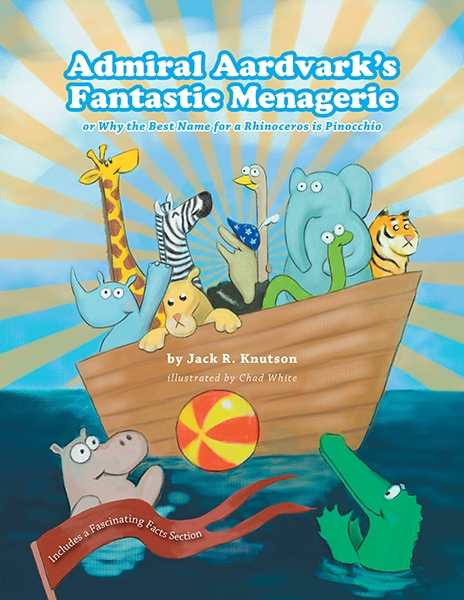
Admiral Aardvark's Fantastic Menagerie
Or Why the Best Name for a Rhinoceros Is Pinocchio
Admiral Aardvark leads his ark of animals on an adventure through children’s dreams in this winsome picture book filled with humorous poems.
In Admiral Aardvark’s Fantastic Menagerie, a charming picture book by Jack R. Knutson, poetic language and soothing images set the stage for the ten poems that introduce various animals on Admiral Aardvark’s ark as it sails through “childhood’s rainy day window.” The mirth-filled poems will delight children ages four and up.
The simple yet bewitching illustrations are set in muted tones and depict adorable animals, often with a hapless or dreamy look in their wide eyes. The book introduces friendly creatures such as a tiger named Purr and zebras named Licorice and Candy.
The language in the poems offers humor, enticing descriptions, and parodies of human emotions. For example, vivid imagery is revealed in the poem “What’s the Purpose of a Hippopotamus?”: “Drawbridge mouth opens like a castle gate / Showing ivory teeth like a portcullis grate.” In “I’d Rather be a Rhinoceros,” a “rhinoceros lady” laments her weight: “It is hard to be dainty / When you’re three thousand pounds / Heavy and weighty.”
The rhyme scheme (aa, bb, cc, dd, etc.) is pretty consistent, but sometimes the construction of a line is awkward as it forces accommodation of a rhyme, as seen in “Crocodile Smile”: “I would reply so politely, ‘If you’d like to know / Take a look in my mouth and you I will show!’” The scarcity of punctuation also causes the flow to falter; the lines read like run-on sentences until the pattern of rhyming couplets becomes familiar. Take, for example, the introduction of Admiral Aardvark: “His favorite meal a bowl of ants / His tail lassos around his pants / With golden buckle and telescope / He keeps special magic in an envelope.”
While the illustrations, the poems’ fun language, and the plethora of animal information are alluring and engaging, the pièce de résistance in this children’s book is the concluding song, “Alone After School.” The poet shares his experience of solitude on the playground, waiting for friends to come along, and his realization that he is his own best company: “But no matter how lonely I might feel / I have inside me what is most real / And the best that can ever happen to me / Is having myself to know and to be.” While the inclusion of this touching ditty is somewhat curious since it doesn’t fit in with the theme of animals, it contains a positive message to boost the self-esteem of solitary children, and offers inspiration to find enjoyment and wonder in the company of their own imaginations.
Admiral Aardvark’s Fantastic Menagerie is a cheerful, alluring adventure into the realm of words and imagination.
Reviewed by
Maya Fleischmann
Disclosure: This article is not an endorsement, but a review. The publisher of this book provided free copies of the book and paid a small fee to have their book reviewed by a professional reviewer. Foreword Reviews and Clarion Reviews make no guarantee that the publisher will receive a positive review. Foreword Magazine, Inc. is disclosing this in accordance with the Federal Trade Commission’s 16 CFR, Part 255.
